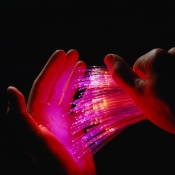Jun 7 2010
Scientists at the Universidad Carlos III of Madrid (UC3M) have proven the validity of tomographic representation of quantum states, which can help quantum technologies transmit information more safely and efficiently.

Any physical system - be it an electron, a molecule of water, a virus, a human being, a whole planet – is characterized at each moment in time distinctively and specifically in a specific place by particular characteristics. This is what we call the “state of the system”, but when one tries to describe said “state” precisely according to our current knowledge of the laws governing the universe, it is necessary to appeal to abstract formulations since the laws of quantum physics, the theory of physics which best describes the universe in which we live, are different from those that govern Newton’s classical physics. In the last century various scientists obtained different representations which help to understand the world of quantum mechanics, which prevails in the area of the smallest things, of the subatomic. Now researchers at UC3M working with the tomographic description of quantum states have proven that it is equivalent to classic descriptions carried out by the great scientists of the 20th century in that they contain the same information and are equally as rich as the classic descriptions.
“We are trying to mark the limits of the conceptual aspects of tomographical representation of quantum states and we just finished proving that the tomographical representation of quantum states is complete, meaning that it is just as good as the traditional representations from Schrodinger, Heisenberg, Dirac, etc.”, states the UC3M professor Alberto Ibort. He has been carrying out research in this area for some years and has recently published a summary of his discoveries on the tomography of quantum states in an article in the journal Physics Letters A, in collaboration with scientists from Lebedev Physics Institute (Russia) and the Frederico II University of Naples (Italy).
The quantum world in detail
What these researchers are trying to do is dissect quantum states in order to describe their true nature in a similar, although more sophisticated, way in which some hospital diagnostic machines work. “A tomographic image of a quantum state describes the quantum state completely, the same as an ordinary tomographic image allows us to see an organism or a body in complete detail”, explains Professor Ibort, of the Mathematics Department of UC3M. In this way, a tomographic image of a quantum state is a mathematical function obtained when carrying out certain manipulations of the physical system intended for analysis, in the same way that computerized tomography used in hospitals obtains a function of the density of human tissue in any direction in order to reconstruct a 3D image of our body.
The use of tomography techniques can have huge implications in communication technology, according to the researchers. “If quantum tomography is developed in the same way as medical tomography, we could use methods derived from it to improve information transfer through quantum channels,” states Alberto Ibort. And one of the principal applications of quantum technologies is the manipulation and transfer of information using quantum properties of light. In this sense, quantum tomography permits the manipulation of light at a quantum level in a different and more versatile way. For example, one could think of “compressing” quantum information (qbits) using a tomographic representation of it, according to experts.
The field of Quantum Information is one of the most promising areas of development within Physics and it is even more relevant in quantum cryptography and quantum computation. These technologies promise, for example, absolutely secure communication and immense computational capacity, in that they are destined to revolutionize our lives in the same way laser or personal computers have.
The researchers at UC3M lead the research project QUITEMAD (QUatnum Information Technologies MADrid), a scientific consortium which brings together experts in quantum Information from the Universidad Complutense of Madrid, the Universidad Politécnica of Madrid and the Consejo Superior de Investigaciones Científicas (The Spanish National Research Council), with the support of national and international companies and funding from the Comunidad de Madrid (Madrid Autonomous Region) and the European Social Fund. “We are working in collaboration with other members of QUITEMAD on the development of techniques from the telecommunications world for use in quantum tomography and we would particularly like to develop an analogue to the sampling techniques which are so useful in the telecommunications domain in analysis of certain kinds of quantum states,” reveals professor Ibort.
Source: http://www.uc3m.es/portal/page/portal/home